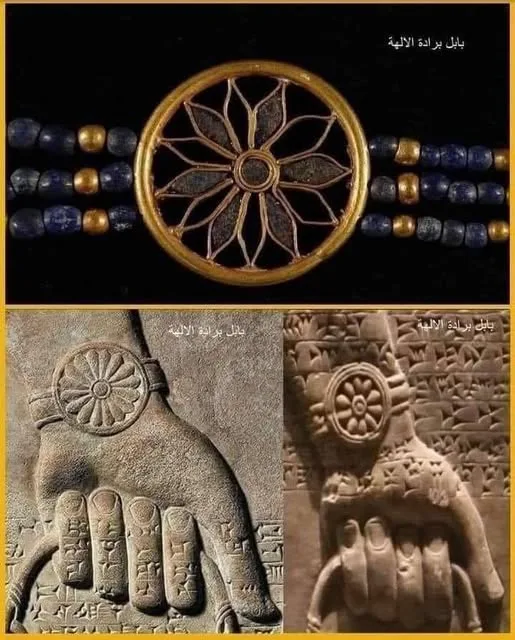Here in Phnom Penh, where our own rich history is etched into the stone of Angkor and the intricate designs of traditional jewelry, we understand the power of symbolism and craftsmanship. It’s easy to look at ancient artifacts through modern eyes and see something entirely different from what was intended. One fascinating example that has long captivated enthusiasts and sparked wild speculation is the so-called “Sumerian wristwatch.”
Take a moment to examine this intriguing visual evidence:

In the top panel, we’re treated to a close-up of a stunning circular artifact. Crafted from gold, with a delicate, almost floral or rosette-like pattern, it’s strung onto bands of deep blue beads (likely precious lapis lazuli) and smaller gold beads. This is a real piece of ancient jewelry, recovered from archaeological sites.
Below, the bottom panels showcase ancient Sumerian carvings, perhaps from a stela or a temple wall. Here, we see figures—whose hands are depicted with remarkable detail—adorned on their wrists with precisely these same circular, rosette-like objects. The visual connection between the unearthed artifact and its depiction in ancient art is undeniable.
For years, these mysterious circular objects, prominently displayed on the wrists of powerful figures and deities in Mesopotamian art, have ignited fervent theories. Fuelled by modern concepts of technology and a desire for the extraordinary, many have speculated that these are evidence of advanced ancient technology or even extraterrestrial artifacts. The notion of ancient Sumerians sporting “wristwatches” from another world is certainly captivating.
However, as experts in Mesopotamian history and archaeology remind us, the truth, while less sensational, is far more enriching for our understanding of this foundational civilization. The “Sumerian wristwatch” is now firmly understood to represent something much more grounded in their culture: a decorative bracelet or an armband.
The True Meaning: Status, Wealth, and the Divine
In ancient Sumerian society (and indeed, across many ancient cultures), personal adornment was far more than just fashion. It was a potent form of communication, a visual language that conveyed profound messages:
- Symbol of Status and Wealth: The materials themselves – gold and lapis lazuli – were exceptionally precious. Gold was a rare and valuable metal, and lapis lazuli was imported from distant Afghanistan, indicating immense wealth and trade networks. Adorning oneself with such materials clearly broadcasted one’s high standing in society.
- Divine Favor and Power: When depicted on gods, kings, or high-ranking priests, these elaborate armbands emphasized their societal or celestial importance. They were often worn by figures interacting with deities, suggesting a blessed connection or a representation of divine authority on Earth. The intricate rosette pattern, common in Mesopotamian art, often symbolized the sun or a star, further connecting the wearer to cosmic power and divine favor.
- Ceremonial Significance: These weren’t everyday wearables for everyone. Their prominence in formal art suggests they were likely worn during important ceremonies, religious rites, or as part of ceremonial regalia, signifying the wearer’s role and importance in such events.
This clarification doesn’t diminish the wonder of these artifacts; on the contrary, it deepens our appreciation. It transforms a perceived alien gadget into a powerful symbol of Sumerian civilization’s values, their artistic mastery, their social hierarchy, and their profound connection to the divine.
The story of the “Sumerian wristwatch” serves as a crucial reminder of the importance of interpreting historical artifacts through the lens of their own time. Without the diligent work of archaeologists and historians, who meticulously study context, materials, and iconography, we risk projecting our modern assumptions onto the past.
From our vantage point in Southeast Asia, where ancient jewelry and symbolic adornments like those from the Khmer Empire also tell stories of status and spirituality, this Sumerian example reinforces a universal truth: that across time and continents, humanity has used beauty and symbolism to express its deepest beliefs and social structures. The “Sumerian wristwatch” is not a piece of alien tech, but a beautiful, eloquent testament to a magnificent ancient culture.





